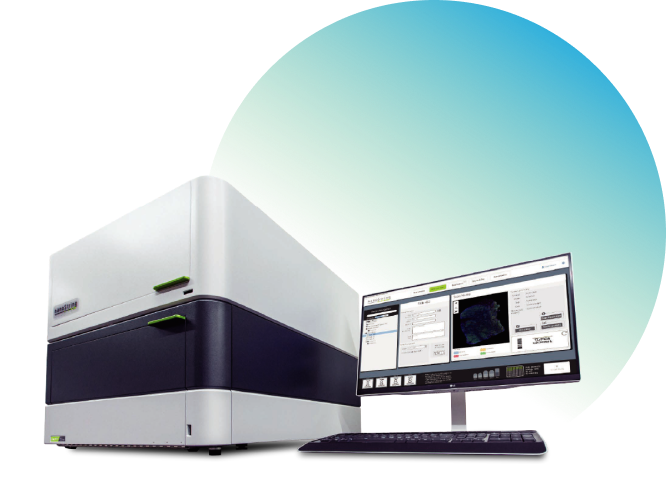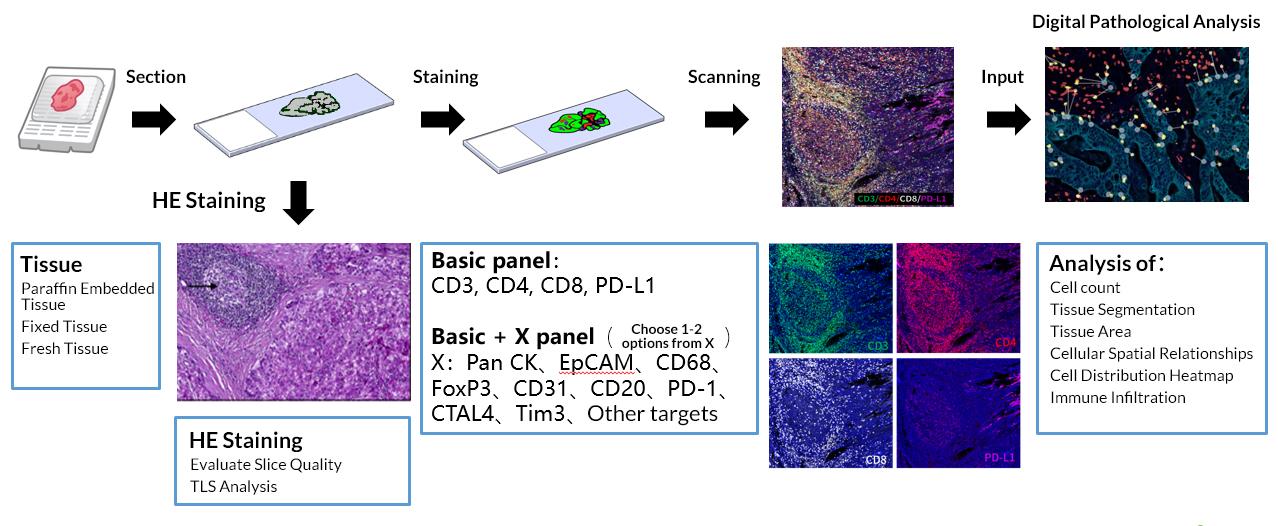
In living organisms, cells interact and assemble within a three-dimensional structure, and the position of each cell is as important as its intrinsic characteristics, and its functions are influenced by the surrounding microenvironment. The study of multiple omics such as proteomics/transcriptomics in space helps us to have a more comprehensive understanding of molecular mechanisms, biological processes, and disease occurrence and development in organisms. In 2022, the spatial multi-omics technology was selected as one of “Seven technologies to watch in 2022” by the journal Nature. Dunwill has the following techniques for anayzing spatial expression of proteins/mRNAs.
D-Mind mIHC DigiPatho (D-Mind)
D-Mind mIHC DigiPatho is a comprehensive digital pathology workflow solution developed by Dunwill, and it integrates tissue slides’ HE staining, multiple immunofluorescence staining (mIHC), and artificial intelligence digital pathology image analysis. D-Mind mIHC DigiPatho has basic panel and basic+X panel. The members of the basic panel include CD3, CD4, CD8, and PD-L1; Basic+X panel adds 1-2 biomarkers to the basic panel, such as PanCK, CD68, FoxP3, CD31, CD20, CTLA4, PD-1, and Tim-3. The D-Mind mIHC DigiPatho platform is based on a fully automatic multispectral imaging system, which can achieve fast and high-resolution scanning of images. At the same time, artificial intelligence technology can recognize and statistically analyze different cell subtypes on the entire slide, which can measure the number and density of various microenvironmental cells, in the core of tumor or the tumor invasion margin, and spatial relationship information between cells in tumor tissue samples. Based on the above functions, the D-Mind mIHC DigiPatho platform can accurately evaluate the immune microenvironment status of tumor tissue in the spatial dimension, assist in predicting the patient's response to immune checkpoint inhibitors, and provide more information for Developing clinical protocols for immunotherapy and patient prognosis prediction. In addition, the D-Mind mIHC DigiPatho platform can greatly contribute to basic research.

HALO Digital Pathology Analysis Platform
HALO possesses high analytic performance like simple, scalable, high-performance, and fast. It can also perform quantitative analysis, cell clustering analysis, cell spatial analysis, Serial registration analysis, and other analytical functions on various stained slides such as IHC and mIHC. HALO AI further optimizes functions such as nuclear segmentation, cell membrane segmentation, and tissue classification, making HALO analysis faster and more accurate, and expanding the scope of HALO analysis.

GeoMx Digital Spatial Profiler(DSP)
GeoMx DSP is a technology that can detect and analyze transcriptome and proteome in situ in tissues. Compared with traditional methods, DSP combines pathological images with sequencing data to analyze the cellular heterogeneity of the internal spatial structure of tissue slides, which helps to solve major biological science problems. GeoMx DSP can display gene expression profiles up to the full transcriptome and up to 100 validated protein expression profiles from up to 12 tissue slides per day.




